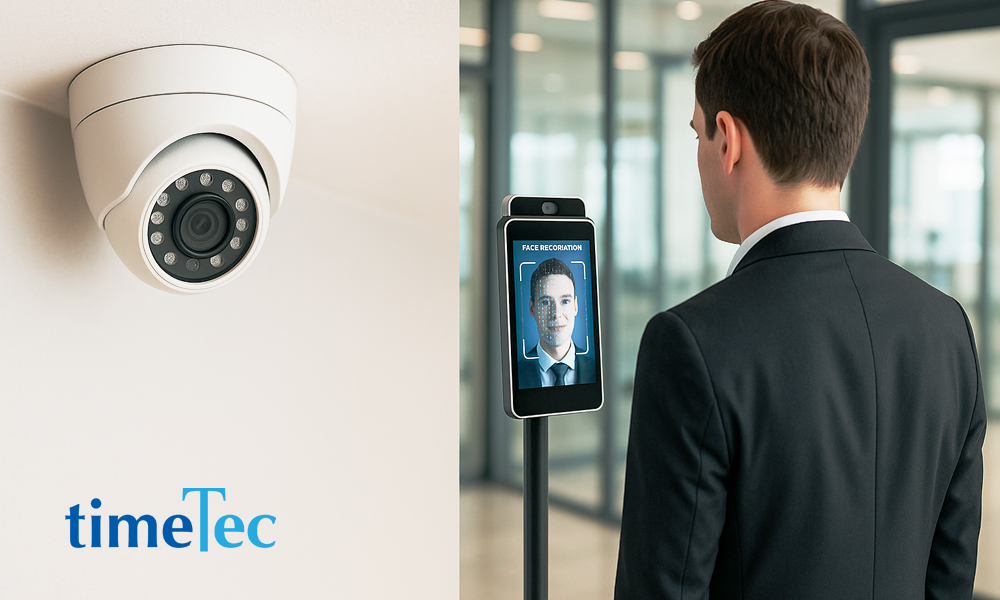As face recognition technology becomes increasingly accessible, many organizations are considering how to implement it for time and attendance tracking. Two common approaches are emerging: integrating face recognition software with existing CCTV systems or using dedicated face recognition devices designed specifically for biometric attendance. Each solution has distinct advantages depending on your workplace needs and environment.
CCTV, short for Closed-Circuit Television, typically includes cameras such as bullet and dome types, which are widely used for security and surveillance. While originally intended for monitoring and recording activity, CCTV systems can be enhanced with software to identify faces and log attendance data. In contrast, face recognition devices are standalone terminals built solely for biometric identification, equipped with specialized hardware to ensure speed, accuracy, and security.
Let’s break down the pros and cons of each based on purpose, performance, cost, and flexibility to help you determine which is more suitable for your time and attendance strategy.
1. Hardware Purpose and Optimization

CCTV with Face Recognition
CCTV cameras are built for general surveillance and often capture wide areas, which makes them less suitable for close-up, high-precision biometric identification. Their wide field of view can make it difficult to detect faces consistently, especially when lighting is inconsistent or when subjects do not face the camera directly.
Face Recognition Device
These devices are purpose-built for biometric time attendance. They include components such as infrared sensors, depth cameras, and controlled lighting to capture facial data accurately. Their hardware is optimized to enforce proper distance and alignment, ensuring consistent recognition in various conditions.
Our Verdict
For accuracy and reliability, face recognition devices are better suited for attendance tracking due to their specialized design.
2. Recognition Accuracy and Speed
CCTV with Face Recognition
The accuracy of CCTV-based systems depends heavily on the software and the quality of the video stream. Recognition performance may vary if individuals are walking by, looking away, or if the network introduces latency during processing. The system may also require backend servers or cloud computing to perform facial analysis.
Face Recognition Device
These devices deliver fast and reliable identification, typically within one second. Since they process data on the device itself, they avoid delays associated with cloud-based systems. Users are guided to face the scanner properly, which increases the chance of a successful match.
Our Verdict
In terms of speed and consistency, face recognition devices offer a clear advantage.
3. Integration and System Design
CCTV with Face Recognition
This approach often requires multiple components: a camera network, facial recognition software, storage servers, and integration with an attendance or HR system. The setup can be complex and may need ongoing configuration and IT involvement.
Face Recognition Device
Standalone devices are typically designed for plug-and-play use. Most come with built-in software or APIs that simplify integration with payroll and HR platforms, making deployment faster and easier.
Our Verdict
For organizations seeking a simpler and more streamlined setup, face recognition devices are the more practical choice.

4. Coverage and Flexibility
CCTV with Face Recognition
CCTV systems can monitor large areas and capture multiple individuals within a single frame. This allows for walk-through or passive attendance tracking, making them suitable for open spaces like lobbies or factory floors. They can function without interrupting foot traffic, which adds convenience in busy environments.
Face Recognition Device
These devices require users to stand in front of them and pause briefly for identification. As a result, they are more appropriate for controlled entry points such as doorways, turnstiles, or gates, but may not scale well in fast-moving or open environments.
Our Verdict
CCTV systems offer more flexibility in terms of coverage and are a good choice for high traffic or large spaces.
5. Cost and Scalability

CCTV with Face Recognition
If a company already has CCTV infrastructure in place, adding facial recognition capabilities can be more affordable in the short term. However, additional costs may arise from software licensing, server resources, and ongoing IT maintenance.
Face Recognition Device
Although these devices carry a higher upfront cost per unit, they are optimized for attendance, require minimal setup, and reduce long-term IT involvement. They are ideal for scaling across multiple access points without complex infrastructure.
Our Verdict
The most cost-effective solution depends on the context. CCTV is more affordable if leveraging existing systems, while face recognition devices are more efficient when rolling out dedicated attendance tracking.
6. Security and Anti-Spoofing Measures
CCTV with Face Recognition
Many CCTV-based systems lack built-in features to detect spoofing or fake inputs such as printed photos or video replays. Any anti-spoofing measures must be implemented through advanced software or external systems, which adds complexity and cost.
Face Recognition Device
Security is a core feature of these devices. Most include liveness detection, 3D sensing, and IR scanning to prevent fraudulent check-ins. These capabilities make them more suitable for high-security areas and ensure that each attendance entry is genuine.
Our Verdict
For environments where security is a top concern, face recognition devices provide better protection against spoofing and unauthorized access.
To help you compare both options more easily, here’s a summary table that highlights the key differences covered above.
| Criteria | CCTV with Face Recognition | Face Recognition Device (Standalone Terminal) |
|---|---|---|
| Primary Purpose | Surveillance system (CCTV) with added face recognition software | Dedicated biometric device designed for time and attendance tracking |
| Accuracy | Moderate to high, depending on software quality, camera angle, and lighting | High accuracy, specifically optimized for facial recognition |
| Recognition Speed | Varies; affected by processing speed and network latency | Fast (typically under 1 second) with real-time processing |
| User Engagement | Passive – users can walk through without stopping | Active – users must face the device and pause for recognition |
| Hardware Optimization | Not optimized for close-range facial recognition | Built-in IR sensors, depth cameras, and optimized lenses |
| Anti-Spoofing / Liveness Detection | May lack anti-spoofing features unless enhanced with AI software | Usually equipped with built-in IR, depth sensing, and 3D liveness detection |
| Integration Complexity | High – requires software setup, servers, AI engine, and system integration | Low – plug-and-play with built-in software or available SDK/API |
| Deployment Effort | Requires custom setup of cameras, angles, software, and video streaming | Easy installation with minimal configuration |
| Network Dependency | High – often depends on cloud or server-based processing | Low – primarily processes data on the device (edge computing) |
| Multi-Person Recognition | Can detect and process multiple faces at once | Typically scans one person at a time |
| Use Case Flexibility | Can also be used for security and general surveillance | Designed strictly for time and attendance management |
| Scalability & Cost | Cost-effective if CCTV is already in place, but software costs may rise | Cost-effective per unit when used solely for attendance |
| Best Use Environment | Ideal for large, open spaces like factories, lobbies, or warehouses | Best for secure entry points such as doors, gates, and turnstiles |
| Data Privacy & Compliance | May require additional effort to comply with biometric data regulations | Easier to manage data privacy and user consent compliance |
When to Choose CCTV
CCTV systems enhanced with face recognition software are well suited for environments that benefit from passive attendance tracking. These systems work best when non-intrusive operation is required, allowing users to check in simply by walking through a monitored area. If your business already uses CCTV with AI-powered analytics, integrating facial recognition could be a cost-effective way to track attendance. Additionally, in large spaces like factories, warehouses, and building lobbies, CCTV offers flexibility and wide-area monitoring without interrupting daily routines.
When to Choose Face Recognition Devices
Face recognition devices are the ideal choice for organizations that require high accuracy, speed, and secure attendance tracking. These systems are designed for use at specific access points, such as office entries, schools, and secure zones, where controlled validation is important. Their out-of-the-box usability and bundled integration options simplify deployment, even for teams with limited technical resources. Companies that prioritize data privacy and compliance will also appreciate the built-in consent management and encryption features that help meet regulatory requirements. For precise, compliant, and scalable attendance tracking, face recognition terminals are the superior option.
Below is a side-by-side table that summarizes the key differences and use cases discussed above.
| Scenario | Our Recommendation |
|---|---|
| Need high accuracy and security | Face Recognition Device |
| Want passive, walk-through attendance | CCTV with Face Recognition |
| Already have CCTV infrastructure | CCTV with Face Recognition |
| Require simple setup and minimal IT support | Face Recognition Device |
| Managing a large open space or factory floor | CCTV with Face Recognition |
Choosing the Right Tool for the Right Environment
Both CCTV systems and face recognition devices have their place in modern attendance tracking. CCTV-based systems provide convenience and wide coverage, especially when passive monitoring is preferred. However, they may lack the accuracy and security features required for controlled environments.
Face recognition devices, on the other hand, deliver fast, secure, and precise biometric identification, making them ideal for companies that prioritize compliance and data integrity. Ultimately, the right solution depends on your operational goals, existing infrastructure, and the level of control you need. With the right choice, organizations can streamline attendance tracking while enhancing security and user experience.
If you’re considering CCTV-based attendance tracking, explore our follow-up article on real-world environments where CCTV with face recognition works best to see practical examples of where this setup truly shines.
